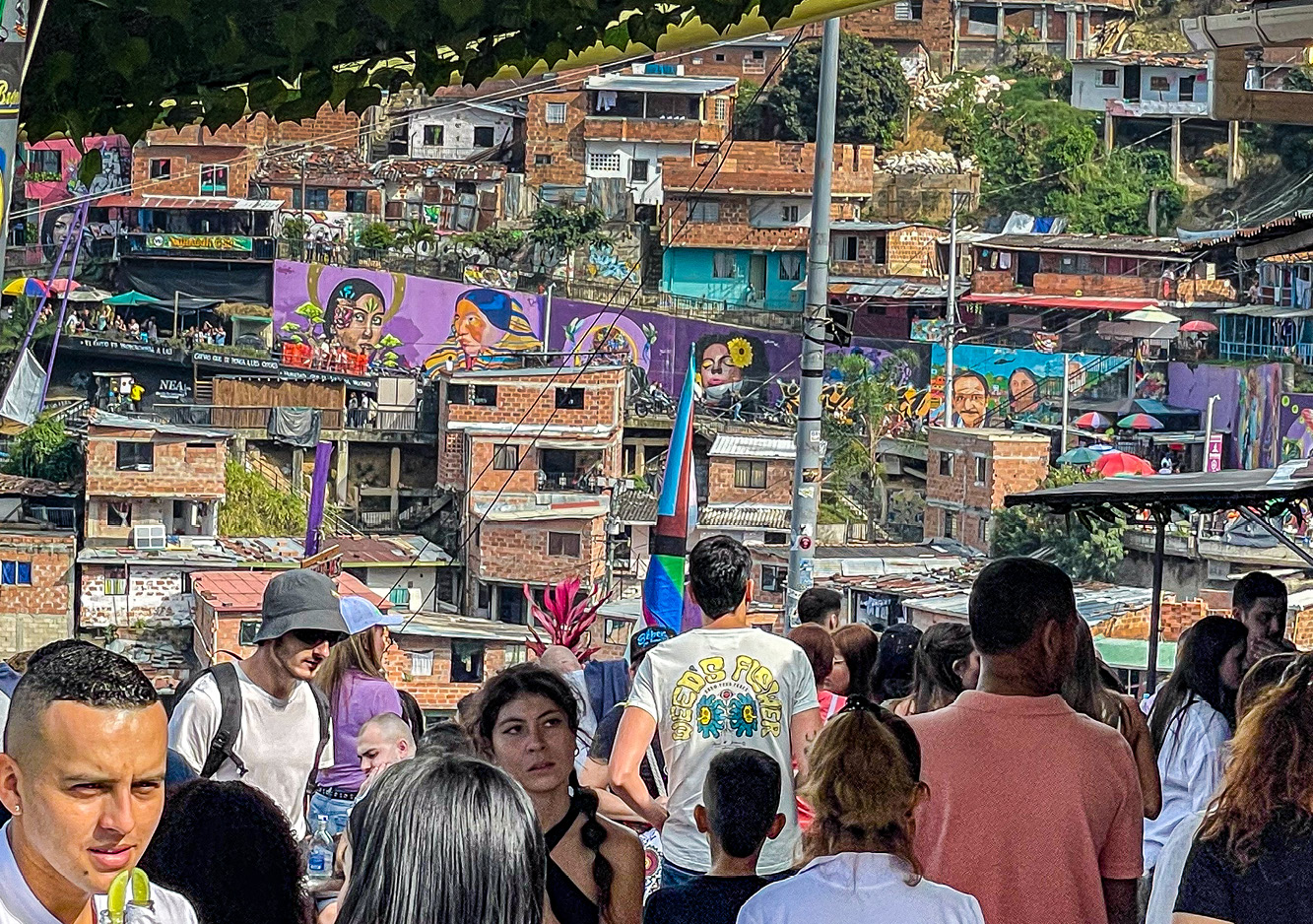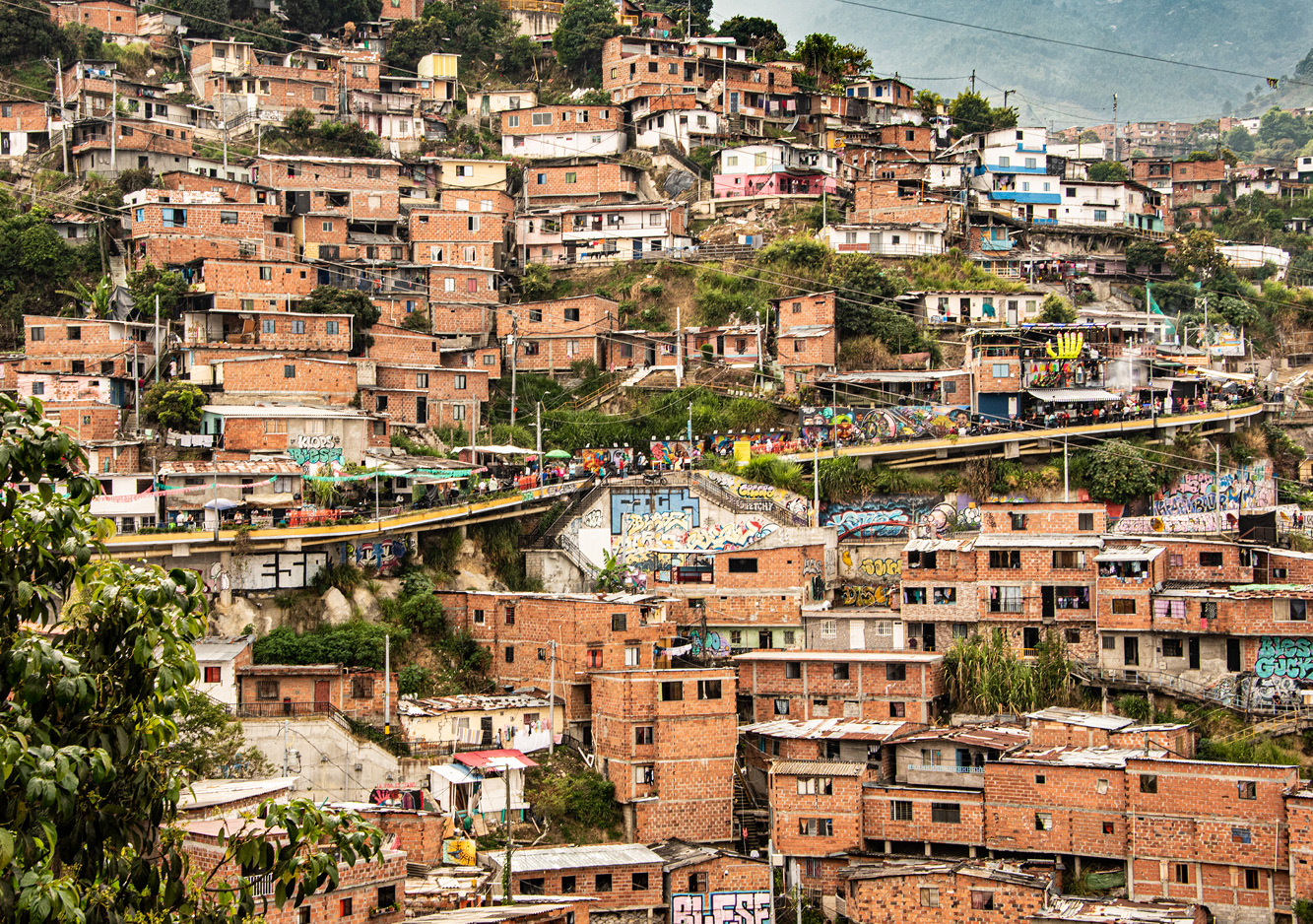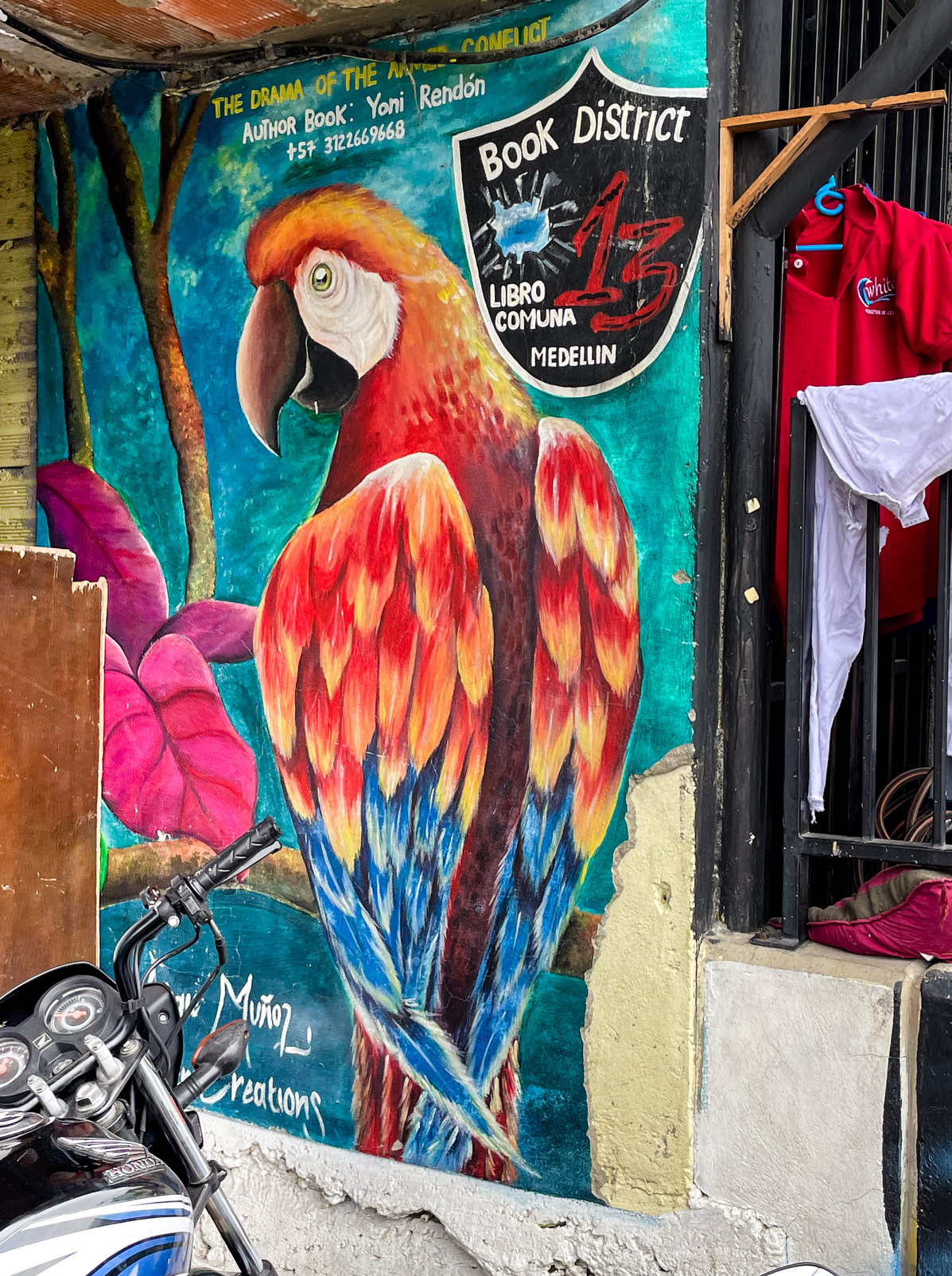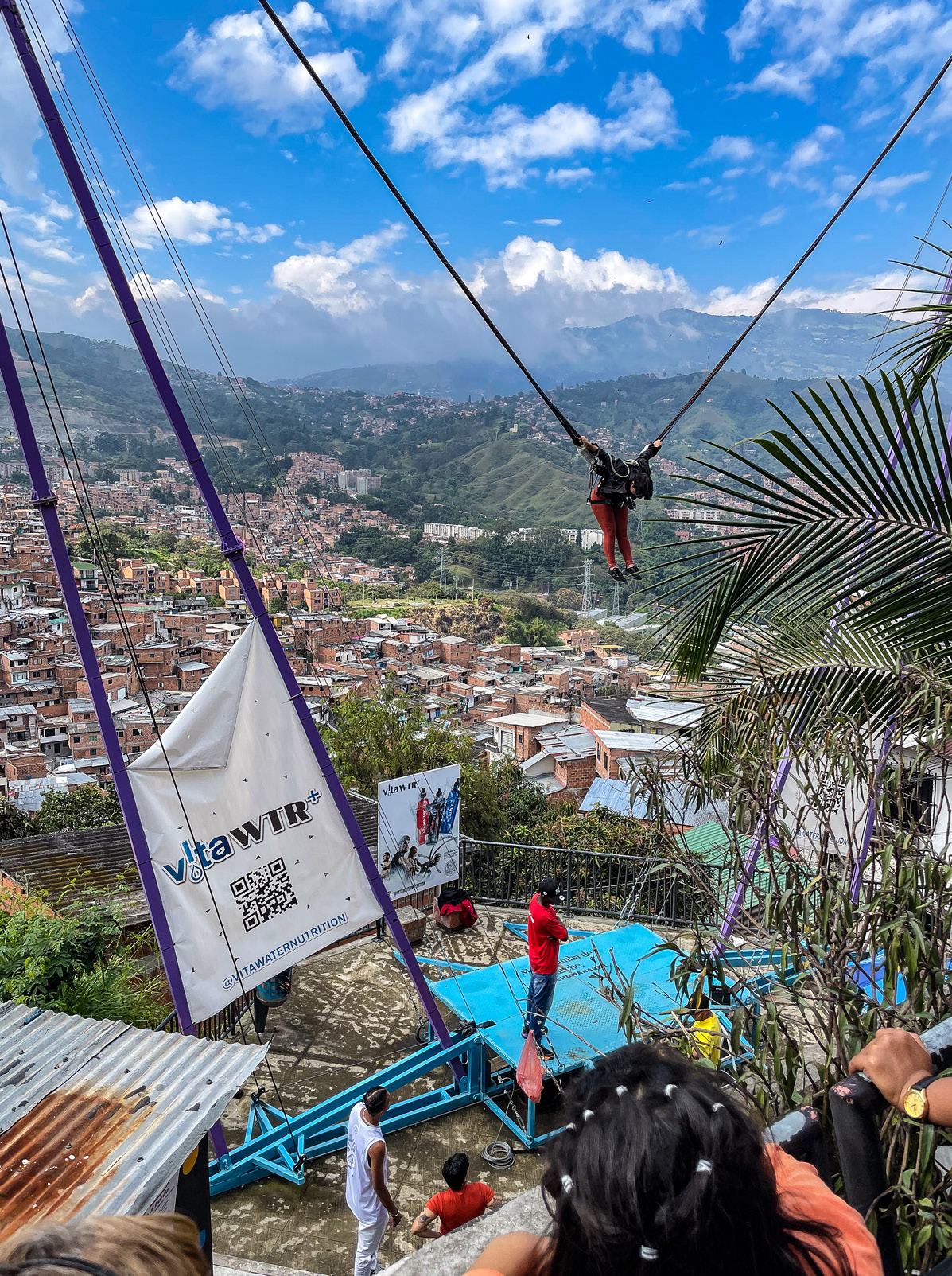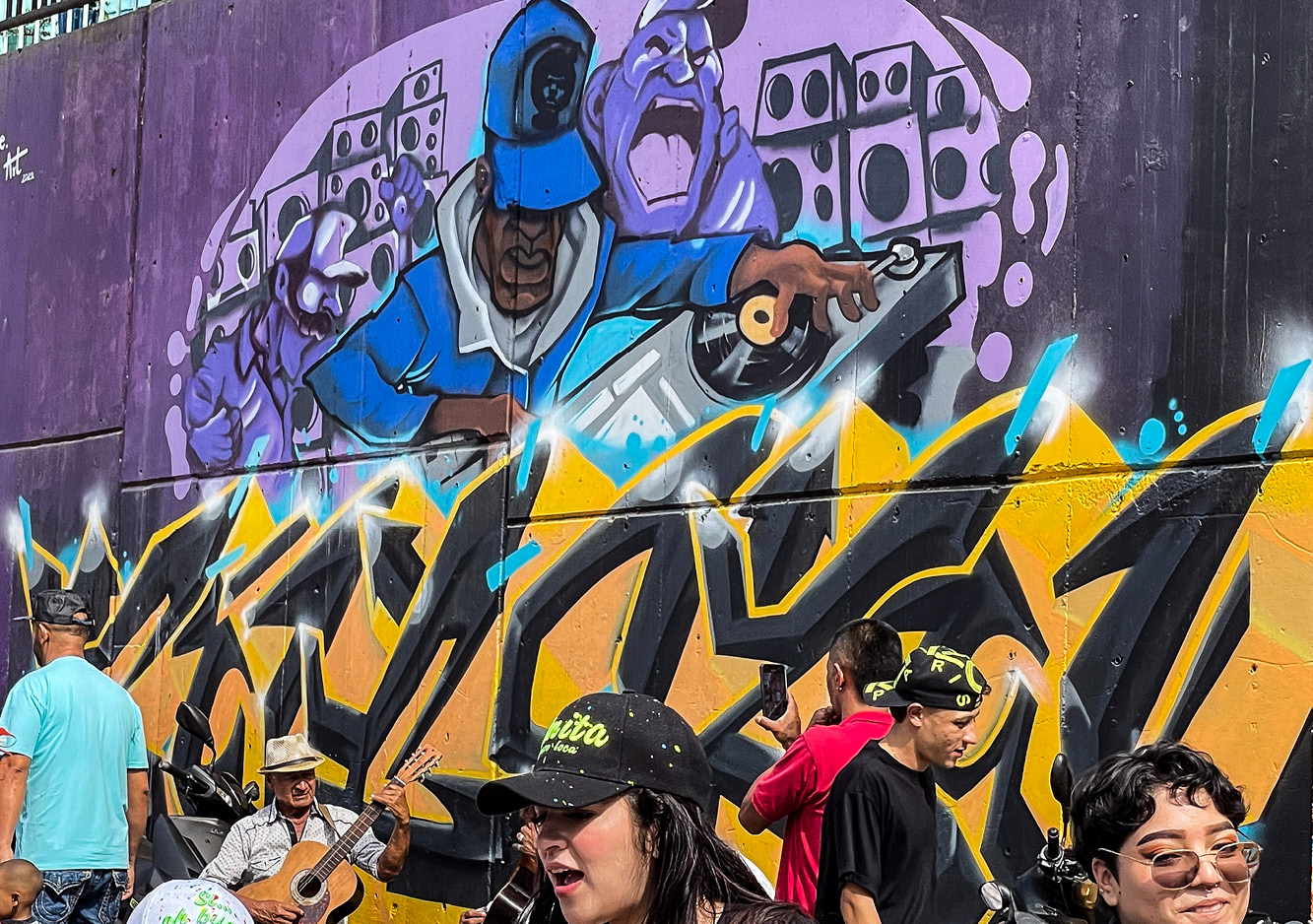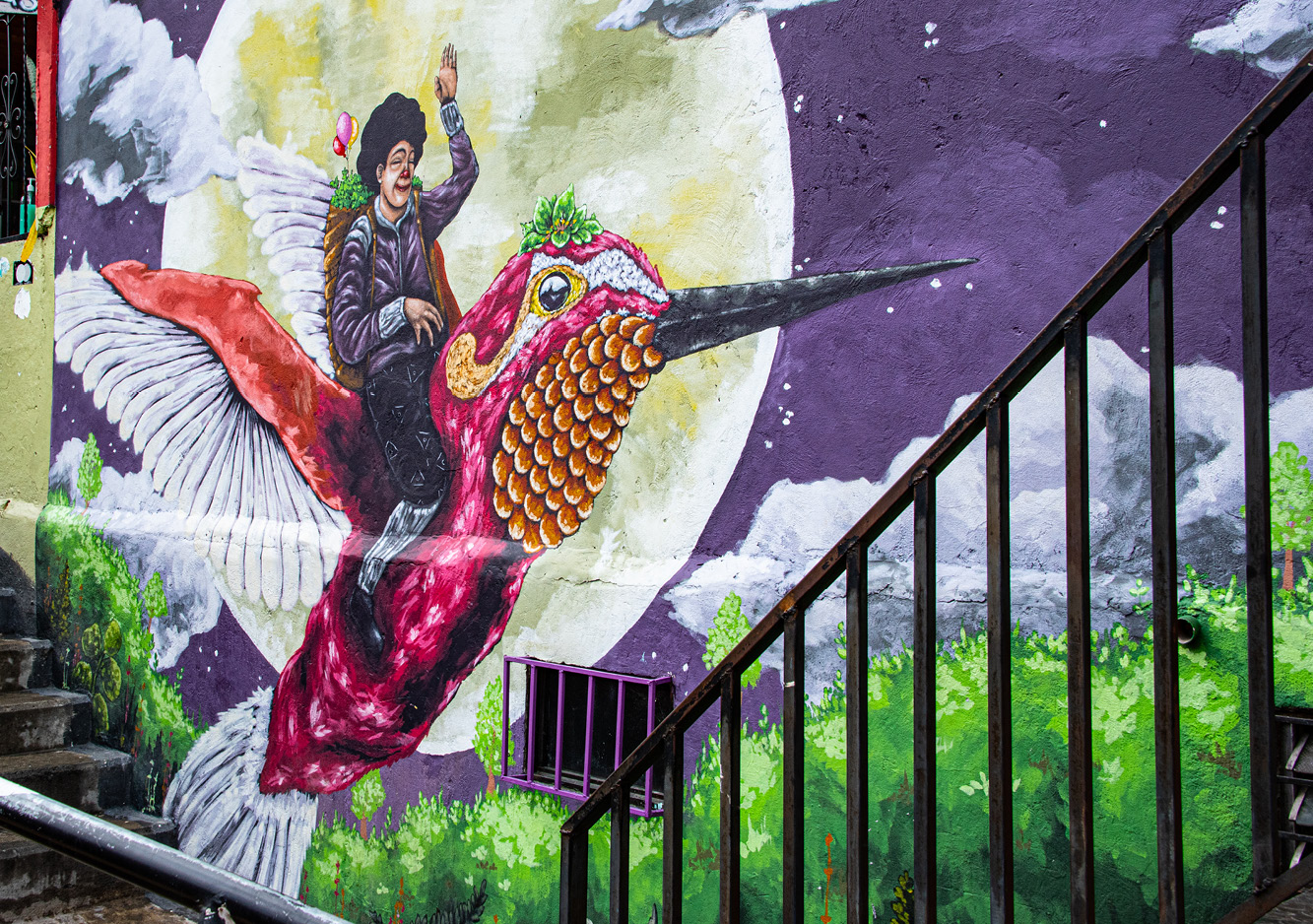I crane my neck to catch an opening through bobbing heads peering over the railing. I’m on a broad concrete ramp that snakes up the steep hillside community of San Javier, an impoverished jumble of brick houses known locally as Comuna 13, located in the west side of Medellín, Colombia’s second largest city.
Suddenly a young man springs into view, suspended between two giant rubber bands, as he slingshots into the air, bouncing up and down in what must be a thrilling experience. The amusement ride attracts a line of mostly young adults and teenagers waiting their turns to be shot skywards. For a moment, I consider joining them.
The Slingshot (my name) is among attractions that bring crowds to this one-time “most dangerous community in the most dangerous city in the world.” That former reputation refers to the cocaine drug wars that plagued Medellín and Colombia for over thirty years. Comuna 13 was Ground Zero for the horror that terrorized residents. But that was then; this is now. Comuna 13’s rebirth symbolizes Medellín’s internationally recognized status as a “phoenix rising” in the arena of urban revitalization.
Pulsating with human energy, color, music, food, and fun, Comuna 13 is now a destination for visitors to Medellín, “City of Eternal Spring.” Our guide Juan Carlos Vanegas wants us to see firsthand what government, working with community residents, can accomplish to transform a devastated neighborhood. Juan Carlos sets the stage with an explanation of the drug-infused conflict of the last thirty years.
An undeclared war ravages Comuna 13
In 1976 notorious narco-terrorist Pablo Escobar established and ran the Medellín Cartel, the nation’s extensive illegal cocaine export business. (By far, the biggest customer for Colombia’s cocaine production was, and still is, the United States.) At the time of his 1993 assassination by government forces, he was one of the richest criminals in the world, his worth estimated at $70 billion.
During the same period, left-wing Communist-inspired guerilla organizations, fighting for the rights of the rural poor, fought the conservative government, using kidnapping, ransom, and drug trafficking to fund their operations. In the wake of a weak government and army that couldn’t defeat the guerilla forces, illegal right-wing paramilitary groups formed to fight them and to protect wealthier citizens. In turn, these forces became brutal and dangerous themselves and took over much of the drug activities after Escobar’s death. The United States, which feared communism would get a foothold in South America, helped to build up the Colombian government and its army in its efforts to subdue the warring factions.
Comuna 13 served guerillas well as a base of operations. Its location provided easy exit routes for drug and arms smuggling, and its lack of streets isolated it from the rest of the city. Bloodshed and fighting terrorized residents.
Bold innovation transforms Comuna 13
Government threw the first rescue line to residents living a hellish daily life in 2002, launching a brutal raid on the neighborhood–– the Orión Operation––that shocked the city. They used 3000 troops, helicopters and machine guns in a “scorched earth” initiative to destroy the guerillas and their drug and arms-smuggling operations.
After this initial controversial action, government replaced the squatter-built makeshift dwellings with brick houses for residents. They opened community centers to provide more social services.
Still, Comuna 13’s vertical geography and lack of streets impeded delivery vehicles and motorcycles. (As in many poorer countries, more affordable motorcycles are the vehicle of choice.) Endless flights of steep steps provided the only way for pedestrians to move around.
To improve vehicular access, in 2011 government built a 12-foot-wide concrete motorcycle path with railing across the face of the neighborhood, an innovative solution to increased mobility. The following year they installed a series of outdoor escalators extending 1300 feet up into the neighborhood. Together with the motorcycle path, the escalators proved to be the catalyst for a dramatic transformation, enabling people to move in and out of the community more easily.
In fact, these investments helped to catapult Medellín onto the international scene as an innovative leader in urban revitalization, garnering accolades as “the most innovative city in the world.”
We join the crowds to stroll an unlikely tourist attraction
It’s a Sunday afternoon. The sky clears up from a torrential downpour. From the bottom of the neighborhood, Juan Carlos leads us up a few flights of steps to reach the motorcycle ramp and join residents, local visitors, and out-of-town tourists that make up a festive crowd of all ages. What strikes me immediately is the dazzling array of murals covering walls, house fronts, any blank space.
Juan Carlos explains that young people, who learned to paint from attending community center classes, exploded the mural art scene with a phantasmagoria of imaginative designs that honor local heroes, depict magical fantasy creatures and other-worldly images, and evoke the community’s recent tumultuous history. I walk past hundreds of large-scale murals that remind me what a psychedelic trip is like; it’s a street art exhibition at a scale I’ve never experienced before.
We wander along the ramp lined with small shops selling sodas, fruit drinks (try guanábana) and street food––like arepas (deep-fried cornmeal patties) or stuffed with potato and minced beef or chicken to make empanadas, or donut-like sweet churros).
Shops selling casual clothing, costume jewelry, and souvenirs round out retail offerings. I ask Juan Carlos who owns the shops. “They are converted living rooms of the houses lining the ramp. Residents own all the shops.” Government forgives payment of taxes and registration fees to support their entrepreneurial efforts.
Latin rhythms and percussions set the tempo
I can’t stop myself from bouncing to the pulsating Latin music and percussive beats that envelop us as we move along the ramp. Teenagers and young boys perform street dances to drumbeats, attracting crowds who cheer them on. Cocktails and beer flow from bars, and patrons climb steps inside to reach rooftop tables, where I can see bodies moving to the rhythms.
We pass the Slingshot ride (oh, I want to!) on our way to the end of the ramp where we walk under two gigantic hands–one glowing green– jutting out of two patios enticing visitors to join festivities. I get glimpses of a party going on above us.
We make our way back a few hundred feet to an exit from the path, down three flights of steps to the top set of escalators for the long descent. Unfortunately, several down escalators are under repair. I imagine the constant use of this machinery challenges maintenance schedules. Still, murals along the descent capture my attention.
Reaching the bottom, the relative calm belies the exciting experience of visiting this bold urban social experiment that supports continued recovery of an impoverished community and serves as a major Medellín tourist attraction.
Comuna 13 provides a dramatic experience not to be missed when you visit the “City of Eternal Spring.”
Tips for Traveling to Medillion's Comuna 13
Non-Stop Flights from the U.S. to Medellín:
- 10 daily from Miami
- 1 daily from New York City, Orlando, Atlanta, and Los Angeles
To Comuna 13 by train from central Medellín:
- From San Antonio train station, take the orange B line to San Javier station (last stop). It’s a 25-minute walk up the hill to the Escalators. A taxi from the station to the Escalators is less than $2.00.
- Tourists often stay in El Poblado district.
From Poblado Metro Station, take Line A in the direction of Niquia. After 4 stops, change at San Antonio Station for Line B to the last stop: San Javier Station.
To Comuna 13 by Uber from central Medellín: Designate Comuna 13 Escalators as the destination.
Recommended:
- Hire a guide to take you or join a small tour group for half-day trips. Check online for tour options.
- I used Aracanto Tour Specialists for our full Colombia trip. Felipe and Margoth Rico will help you plan your visit to Medellín, provide you with an excellent guide (ask for Juan Carlos Venegas), and help you plan your stay elsewhere in Colombia.

